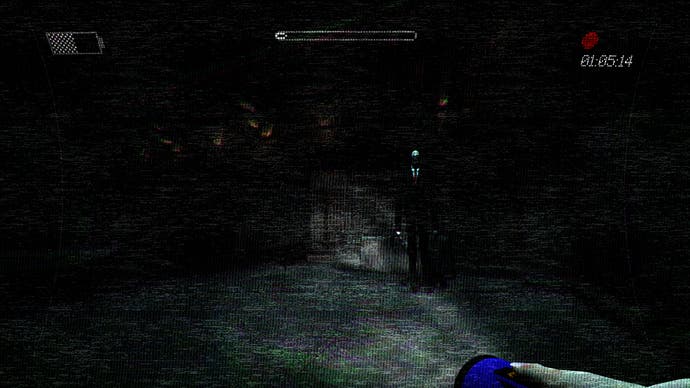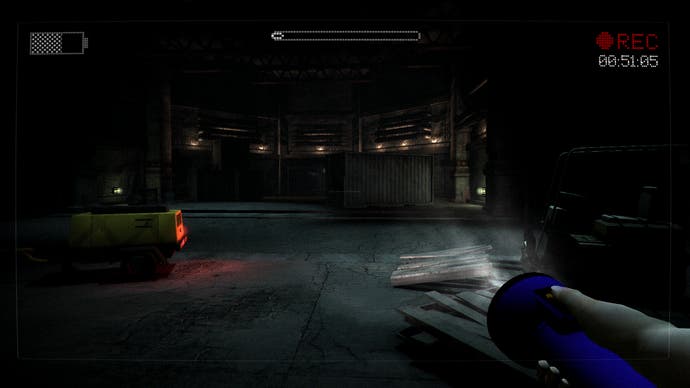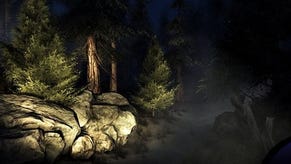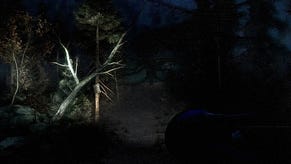Slender: The Arrival review
He's behind you.
Slender: The Arrival is a work of horror, but 'horror' doesn't come close to covering the emotional journey involved. Angst comes first. It arrives after you leave the muffled safety of your Jeep and twist through the trees towards an old friend's mansion for a reunion. As any walker knows, night doesn't fall in a forest. It rises, up from the brush, in great billowing shadows. By the time you make it to the front door the light has entirely failed, the darkness surged through the leaf canopy, up and up, to form a unanimous night.
Angst turns to concern when you find the house open, but haggardly deserted. The windows are open, the TV emits a threatening buzz of static: oh no, where is she? Just as you locate a torch on the dining room table amongst the other domestic debris, a scream streaks in from the back yard. Now concern contorts into anxiety as the implicit is made audibly explicit. There might be any number of legitimate reasons for a house to be deserted, but there's usually only one reason a woman shrieks in the countryside at night. Against your better instincts, you trip down the staircase, obeying the game's monolithic, unsympathetic instruction to Investigate scream beyond the back gate.

Fear comes next, as you creep back into the forest in search of the screamer. Like the forest dark, fear grows upwards, from the inside as your mind shines a torch on formless childhood memories, somehow linked to the scene in your subconscious - the time you lost sight of your mother in the supermarket; the night you woke in bed, paralysed by the knowledge you were no longer alone. You hear another's footsteps close by, but when you swivel to look, there's no one there. In this self-doubt (am I hearing things?) fear tightens its coil and slowly deafens when you find the first page from your friend's diary, nailed to a tree ("Help me!"), pinned to a concrete wall ("Go home"), on the aluminium side of a radio tower. A heartbeat pulse thuds in the soundtrack.
Next comes terror, bursting from fear's chest. The screen of your camcorder (through which you view everything in this dark, simple game) bends and shudders with a disorientating blast of static. That's when you know for sure that, not only are you not alone in this forest, but the thing is nearby and in full pursuit. You inch forward, torch sweeping with smooth, deliberate movements. But when terror arrives you sprint like a wild woman, swiping the light beam back and forth and up and down in order to catch a glimpse of your tormentor as he closes, unseen and yet revealed in the wibble of the screen and your hell-quickened breath.
The peril is make believe, but it's happening to you, and the private fears and scare memories triggered here are all too real

Now - and only now - horror, as the light catches your aggressor, a tall, gaunt, be-suited man with china plate eyes. Your lens buckles madly in his presence and you forget which way is up or why. Sprint lucky and you're free to search the thickets for the next of the eight diary pages - each scrap of paper amplifying the heartbeat pulse in your ears, and increasing the rate at which Slender Man can hunt you down. But run into his lank arms and the camcorder will glitch out, as the horror climax gives ways to the cool, white death of the Game Over screen.
Video games are not movies. That much is clear from even a short amount of time spent strolling Slender: The Arrival's grimly handsome locales. For while these are sets more than they are places (somebody arranged the trees, set the table in your friend's home, pinned the diary page to the abandoned truck) the experience of being hunted, rather than merely viewing an actress run for her life on screen, offers something quite different to the cinematic experience. The peril is make believe, but it's happening to you, and as such the private fears and scare memories triggered here are all too real.

Developer Parsec Productions - which made the phenomenal free Slender game, and collaborated with Blue Isle Studios on this update - understands this strength and, before the game begins, tries to strike a bargain with players that they suspend their disbelief and dwell on past real-life experiences of fear. It's a neat trick (certainly neater than the twin clichés of open windows and a humming television in a deserted house). Likewise, Slender utilises the early Resident Evil games' ploy of limiting your controls to create a sense of disempowerment: you can only point your torch, click on objects to activate them or, rather awkwardly, open doors by swiping the mouse cursor upwards.
While some of Slender's potency is numbed through the repetition (this is a short game, but completing the four main chapters will require multiple attempts), the atmosphere retains its sapping heaviness throughout. Even the snarkiest player will soon forget that this antagonist started life as an internet meme (Slender Man was created by a member of the Something Awful forums in 2009) or that, like all monsters of his ilk, he looks feebly ridiculous in the blue light of day.
In context, however, he is a cipher for every monster a human imagines might harm them in the dark - a role he excels at, by virtue of being able to disregard this world's rules and teleport behind the player, or alongside her, just out of sight. Slender, like all horror entertainment, is principally a game of (repeating) tricks. These include the mounting jeopardy that comes with completing the objectives one by one in each chapter (find the eight pages, activate the eight generators, close the eight windows), or in Slender Man's ability to apparate through the magic of video game code. But it masterfully uses these tricks to tap into honest truths: a fear of the dark that lurks somewhere in every person, the terror of being pursued and the horror of being caught.








